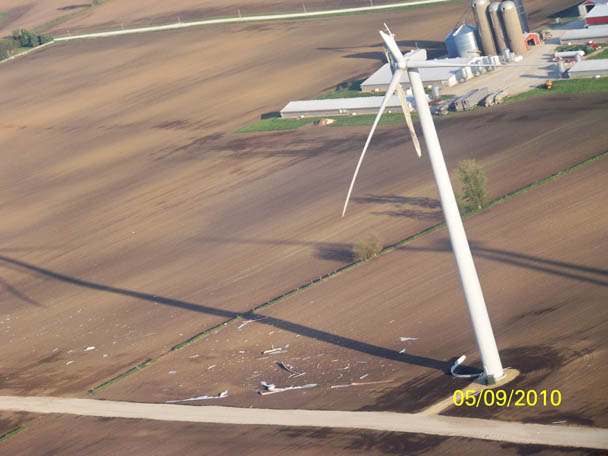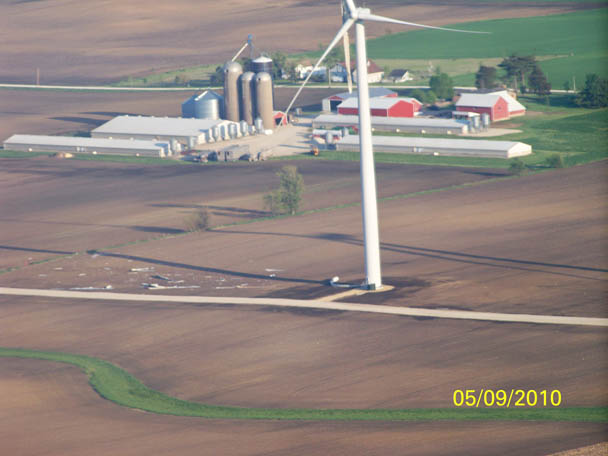Entries in Wisconsin public service commission (7)
5/19/10 UPDATED Surprise, Surprise, Surprise! Draft Siting Rules adopted by PSC without Wind Siting Council members knowing the contents AND regarding the precautionary principle, sorry wind farm residents, you don't qualify for this protection AND wind turbine noise and bird song: What they sound like together AND What does an abandoned wind farm look like?
Click on the images below to watch the entire May 14th Public Service Commission meeting where commissioners adopted draft wind siting rules containing details the Wind Siting Council had never seen or been allowed to discuss. Specifically, setbacks and noise limits.
The draft that was given to WSC members contained no specific numbers and when the subject of specific setbacks or noise limits has been raised by members of council in past meetings, Chairman Ebert quickly assured them there would be a time to discuss these issues in the future and moved on. Under Ebert's chairmanship, no discussion of setbacks or noise limits has been allowed at any WSC meeting.
On May 17th, after the draft rules were adopted by the PSC several members of the Wind Siting Council spoke about these numbers as being a complete surprise.
Better Plan is in the process of uploading the remaining video of this meeting to be followed with video of the May 17th meeting where Dr. Jevon McFadden gave his presentation regarding wind turbines and human health.
While citing the findings of the National Academy of Sciences, the Congressional Research Service and the Minnesota Department of Health-- all of whom agree that at half a mile negative effects from turbine noise and shadow flicker are no longer a significant problem, Dr. McFadden concluded that wind turbine noise and shadow flicker present no potential to negatively affect health and the precautionary principle was unnecessary in siting wind turbines near homes.
What is the precautionary principle?
CLICK HERE FOR SOURCE: Environmental Health Perspectives
Definition of the Precautionary Principle
A 1998 consensus statement characterized the precautionary principle this way: "when an activity raises threats of harm to human health or the environment, precautionary measures should be taken even if some cause and effect relationships are not fully established scientifically". The statement went on to list four central components of the principle: taking preventive action in the face of uncertainty; shifting the burden of proof to the proponents of an activity; exploring a wide range of alternatives to possibly harmful actions; and increasing public participation in decision making.
The term "precautionary principle" came into English as a translation of the German word Vorsorgeprinzip. An alternative translation might have been "foresight principle," which has the advantage of emphasizing anticipatory action--a positive, active idea rather than precaution, which to many sounds reactive and even negative. Although the principle has its roots in German environmental policy, over the past 20 years it has served as a central element in international environmental treaties addressing North Sea pollution, ozone-depleting chemicals, fisheries, climate change, and sustainable development (3). Precaution is one of the guiding principles of environmental laws in the European Union.
Environmental scientists play a key role in society's responses to environmental problems, and many of the studies they perform are intended ultimately to affect policy.
The precautionary principle, proposed as a new guideline in environmental decision making, has four central components: taking preventive action in the face of uncertainty ; shifting the burden of proof to the proponents of an activity ; exploring a wide range of alternatives to possibly harmful actions ; and increasing public participation in decision making.
In this paper [DOWN LOAD IT HERE] we examine the implications of the precautionary principle for environmental scientists, whose work often involves studying highly complex, poorly understood systems, while at the same time facing conflicting pressures from those who seek to balance economic growth and environmental protection.
In this complicated and contested terrain, it is useful to examine the methodologies of science and to consider ways that, without compromising integrity and objectivity, research can be more or less helpful to those who would act with precaution.
We argue that a shift to more precautionary policies creates opportunities and challenges for scientists to think differently about the ways they conduct studies and communicate results. There is a complicated feedback relation between the discoveries of science and the setting of policy.
While maintaining their objectivity and focus on understanding the world, environmental scientists should be aware of the policy uses of their work and of their social responsibility to do science that protects human health and the environment. The precautionary principle highlights this tight, challenging linkage between science and policy.
 Note from the BPWI Rearch Nerd: Better Plan was quite surprised by the commissions sudden adoption of draft rules containing specifics that had not -to our knowledge- been made public. In a process which has otherwise been reasonably transparent, this action by the commission was troubling.
Note from the BPWI Rearch Nerd: Better Plan was quite surprised by the commissions sudden adoption of draft rules containing specifics that had not -to our knowledge- been made public. In a process which has otherwise been reasonably transparent, this action by the commission was troubling.
We were also troubled by Dr. McFaddens conclusion that the precautionary principle was unnecessary for those who will be living near wind turbines sited according to the PSC's guidelines. We'll be posting video of his presentation in the days to follow.
THIRD FEATURE: Click on the image below to see an abandoned wind farm from the 1980's. Though the project was went off line long ago some of the disconnected turbines still spin, others stand with broken blades. The project is located in South Point, Hawaii. A newer wind project was recently constructed nearby.
Click on the image below to hear what wind turbines sound like. Bird song can be heard as well in this clip. One way to get an idea of what wind turbine noise is like is to turn up the volume until the birdsong sounds to be at the right volume. This will give you a rough idea of the level of turbine noise present.
5/15/10 DOUBLE FEATURE: If a 130 foot long turbine blade falls into DeKalb county field and and no one knows why, does it matter? AND Reach out and touch your PSC: They want your comments on the new draft siting rules which look like the old siting rules.
 NOTE FROM THE BPWI RESEARCH NERD: Last week DeKalb county IL was the latest location for yet another "unusual" wind turbine failure resulting in a 131 long blade breaking off for the usual reason: That is: no one knows why it happened. The turbines have been in operation for five months.
NOTE FROM THE BPWI RESEARCH NERD: Last week DeKalb county IL was the latest location for yet another "unusual" wind turbine failure resulting in a 131 long blade breaking off for the usual reason: That is: no one knows why it happened. The turbines have been in operation for five months.




CLICK HERE to read a daily log about one family's life in this wind project
READ THE FULL NEWS STORY BY CLICKING HERE: www.daily-chronicle.com
Turbine Blade Damage 'Unusual"
May 7, 2010
By Dana Herra
SHABBONA TOWNSHIP – Officials at NextEra Energy Resources aren’t sure what caused one of the three blades on a wind turbine south of the village of Shabbona to fail Friday morning. The 131-foot-long blade hung from the top of the turbine Friday, apparently bent at the base and split along its length.
That type of failure is unusual, NextEra spokesman Steve Stengel said.
“Our inspection at this point has just been visual, so at this point we don’t know what caused that,” Stengel said Friday afternoon. “Based on just visual inspection, it’s very unusual to have a blade fail and look like that.”
Stengel said the blade failed about 7:30 a.m. Friday.
SECOND FEATURE:
Public Service Commission seeks public comment on proposed wind siting rules.
wispolitics.com 14 May 2010
MADISON – The Public Service Commission of Wisconsin (PSC) is seeking public comment on the proposed wind siting rules, issued today by the PSC. The proposed rules will ultimately result in uniform wind siting standards for local units of government in Wisconsin and ensure consistent local procedures for regulation of wind energy systems.
“Developing uniform wind siting standards is crucial for a sound energy future in Wisconsin,” said Chairperson Eric Callisto. “I look forward to receiving robust public input on these proposed rules and finalizing them later this summer.”
2009 Wisconsin Act 40 (Act 40) requires the PSC to promulgate a variety of rules that specify the conditions a city, village, town, or county (political subdivision) may impose on the installation or use of a wind energy system. If a political subdivision chooses to regulate such systems, its ordinances may not be more restrictive than the PSC’s rules. The PSC will also consider the restrictions specified in these rules when determining whether to grant a certificate of public convenience and necessity for a wind energy system over 100 megawatts.
The PSC established docket 1-AC-231 to conduct the rulemaking under Act 40. Act 40 requires the PSC to conduct this rulemaking with the advice of the Wind Siting Council. The Wind Siting Council is an advisory body created by Act 40. The Wind Siting Council members have begun to provide input to Commission staff concerning these rules during a series of meetings in early 2010. The PSC will seek comments from the Wind Siting Council on the proposed draft rules issued by the Commission.
Any person may submit written comments on these proposed rules. Comments on the proposed rules will be accepted until July 7, 2010, at noon (July 6, 2010, at noon, if filed by fax). The comments are considered when staff is drafting the rules. The PSC will hold hearings to take testimony from the public regarding the proposed rules in the Amnicon Falls Hearing Room at the Public Service Commission Building, 610 North Whitney Way, Madison, Wisconsin, on June 30, 2010. Act 40 requires that hearings regarding these rules also be held in Monroe County and a county other than Dane or Monroe, where developers have proposed wind energy systems. The PSC will also hold public hearings on these proposed rules at City Hall, Legislative Chambers, 160 West Macy Street in Fond du Lac on June 28, 2010, and Holiday Inn, 1017 East McCoy Boulevard in Tomah on June 29, 2010.
More information on the Wind Siting Council and the wind siting rulemaking pursuant to Act 40 can be found by visiting the Commission’s website and clicking on the Electronic Regulatory Filing System (ERF) at http://psc.wi.gov/. Type case numbers 1-AC-231 in the boxes provided on the ERF system. To comment on the proposed rules, click on the Public Comments button on the PSC’s homepage and scroll down to select Wind Siting Rulemaking.
Contact: Teresa Weidemann-Smith, (608) 266-9600
